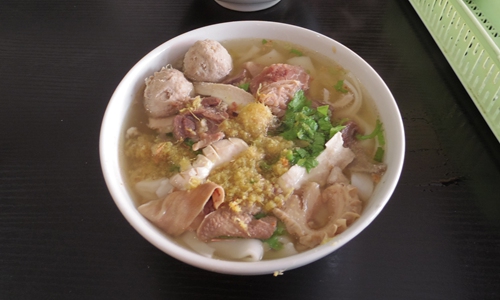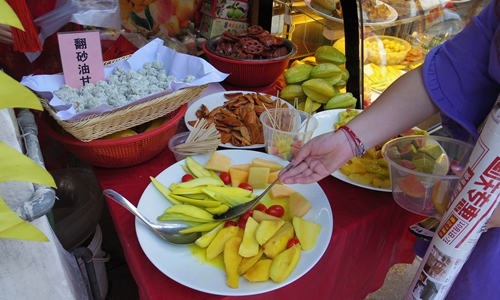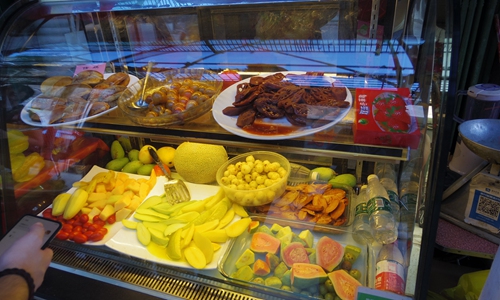Relishing the flavor of South China’s Teochew cuisine
By Bi Mengying Source:Global Times Published: 2019/11/21 15:58:42

Guotiao soup Photo: Bi Mengying/GT

Gancao fruit Photo: Bi Mengying/GT

Gancao fruit Photo: Bi Mengying/GT
Early Chinese immigrants from Canton (South China's Guangdong Province) spread their history, culture and also food for the world to explore. Various recipes of dim sums, chow mein, lo mein, and char siu, are some examples of the popular Cantonese food.
However, things are a little different in the eastern region of the province -Teochew (Chaoshan), which includes the cities of Chaozhou, Shantou, and Jieyang. Unlike the rest of Guangdong, people in Teochew don't speak Cantonese, and the Teochew cuisines display a style of their own. I was able to catch a glimpse of the typical "Cantonese food" during my short trip to Chaoshan.
Yu Sheng
Yu means fish in Chinese, while sheng means something raw. Besides yu sheng, there are also similar varieties of shrimp, lobster, geoduck and cuttlefish. I ordered both yu sheng and xia (shrimp) sheng and was served with thinly sliced raw fish and shrimp strips evenly laid on the plates that seemed to be woven by bamboos. Unlike sashimi in Japan, pairing with the fish and shrimp strips, there was also a dipping sauce and a plate of assorted colorful ingredients including shredded radish, ginger, Tabasco pepper, celery, sliced garlic, onion, star-fruits, limes, and some peanuts.
Judging by the lost look evident on my face, the waiter stopped by and walked me through the intricacies of enjoying yu sheng and xia sheng. After putting a bit of every ingredient in the bowl, he picked a fish strip, which was so thinly sliced that it appeared almost transparent under the light.
"The sauce here is the key. It's our restaurant's secret recipe. You slightly dip the fish here and then enjoy it with the small serving of all the ingredients in the bowl. Eat them together. Do the same with xia sheng, but local people usually finish yu sheng first before they eat xia sheng," he said.
The vibrant colors in the bowl already made the dish very Instagram-friendly and the taste of it was something beyond my expectations. A blend of spicy, zesty, sour, it was like all the flavors perfectly complemented without being insipid. Besides the fresh fish strips, there were also some strips of fish skin, the texture of which was very chewy yet a bit crispy at the same time. Therefore, it was a totally new experience of relishing the skins, the same way as the fish strips that is explicable only when tried in person.
All That Beef
Chaoshan beef meatballs are quite popular across China. People from different regions eat them with hot pot, malatang (a type of street food derived from Southwest China's hot pot), or add them to various kinds of noodles and soups.
As for in Chaoshan, beef meatballs, most of which are handmade, can be found in guotiao (a type of rice noodle in Chaoshan) soup for breakfast. The soup also contains vegetables, making it a well-balanced meal. When it comes to dinner, Chaoshan beef hot pot would be a great choice. Along with the handmade beef meatballs, there is a wide selection of beef available. The soup of Chaoshan beef hot pot is not spicy like the Sichuan hot pot. Instead, it aims to preserve the pristine flavors of the beef, and the locals also fancy savoring the hot pot with a pot of Chaoshan sanbao tea.
Dessert and Snacks
Chaoshan sanbao (literal Chinese translation is three treasures) refers to laoxianghuang, laoyaoju and huangpichi, which are marinated chayote, kumquat, and wampi fruit. The three ingredients each have different health benefits, such as alleviating nausea or cough and warming up bodies. The marinating process is quite complicated and time-consuming. Similar to preserved wine and liquor, it is generally considered, the longer, the better. To be noted, the complex skills for making laoxianghuang, has been inscribed on the list of the intangible cultural heritage of Guangdong Province in 2009. When sanbao tea blends with the three together, not only it's full of flavor with citrus-and-plum-like notes, but it also highly benefits your body, especially given the humid and steamy climate of Chaoshan.
Another equally popular choice for dessert is gancao fruit. The street food is ubiquitous in the Chaoshan area. Nothing looks more luscious than the miscellaneous fruits in different colors arranged neatly. Some of the fruits are total strangers to a northerner like me. The vendor will ask you to pick the fruits you like and toss them with their homemade sauce, which is made from gancao, also known as the Chinese liquorice, often used as a type of sweetener in Traditional Chinese medicine. And the taste of the sauce seemed to be varying from vendor to vendor.
"Our shop has been around for nearly a century. We just moved here from the old movie theater. My father-in-law passed down the recipe to me," said the female owner of a shop named Shunji Gancao in Chaozhou happily. Her husband also proudly took out a jar of the sauce and showed it to me, "You cannot find it anywhere else. It would be different. My father is almost 100-year-old. The recipe, the taste, the store, they are full of history".
Newspaper headline: Not your typical Canton
Posted in: FOOD,CULTURE & LEISURE